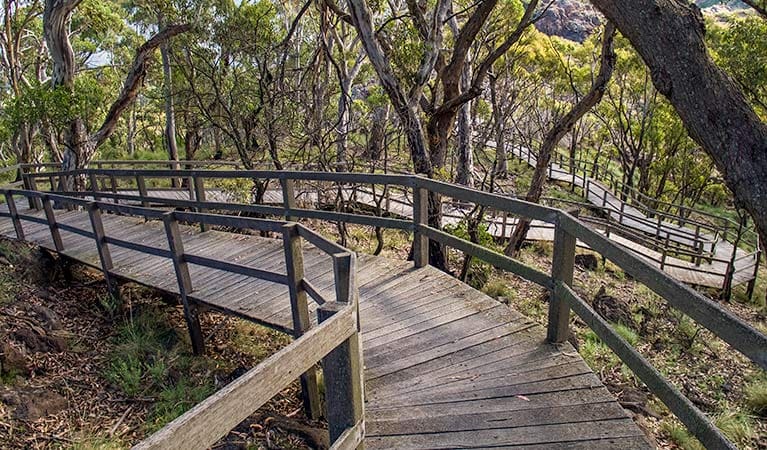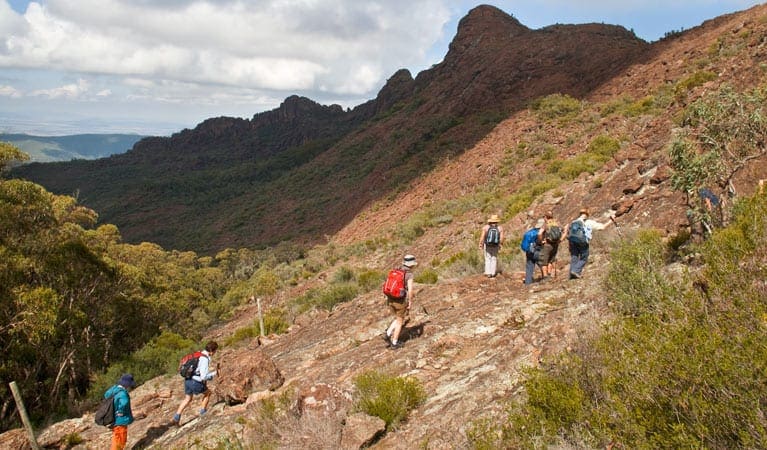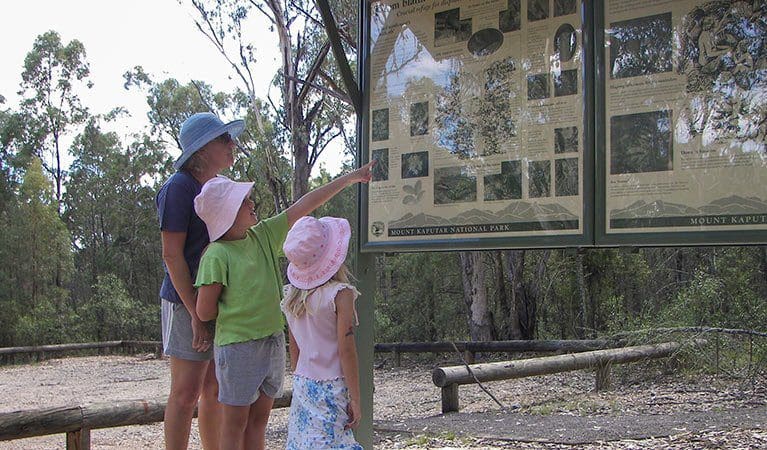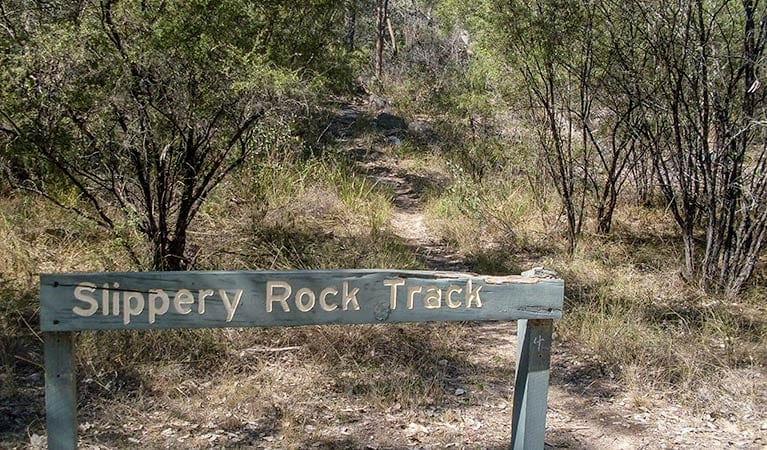Hike at a Glance
Max elevation: 0m
Min elevation: 0m
Total Ascent: 0m
Hike overview
Mount Coryah walking track begins at Coryah Gap carpark and climbs steeply up the stepped ridge. The terraces were formed by a series of lava flows, each new one covering the terraces beneath it.
At the base of the cliffs follow the track around to the left. The track climbs to the top terrace, evidence of the most recent eruption, and then circles around the summit of Mount Coryah in an anti-clockwise direction, providing views to the south, east and north.
From the lookout the return track passes under the northern base of the summit through an impressive stand of grass trees. It then loops back to the track junction at the base of the cliffs. The loop track is very narrow, it follows the cliff edge and can be slippery when wet. If you wish to avoid the cliff edge or it has recently rained you may wish to miss the loop and return the way you came from the lookout.
Tips
This walk involves a steep uphill climb with many steps, so it's important to have a good level of fitness and sturdy walking shoes.
The weather in this area can be extreme and unpredictable, so please ensure you're well prepared for your visit.
Visit NSW National Parks and Wildlife Service for more information on this trail.
The longitude and latitude of the start and end points are approximately only and should not be used for navigation purposes. Please contact me if you know the correct coordinates.
Gallery
Got some great shots from this hike? Upload your photos here to inspire others and show off the beauty of the trail!
Click to view form >>
Submitting your photos doesn’t mean you lose ownership. You can be credited for your contributions, and you can request removal at any time.
Content use
Please don’t copy GPX files or content from this site to AllTrails or other platforms. Each trail has been personally mapped, documented, and refined to support Australia’s bushwalking and hiking community. While some details come from land managers, every listing reflects significant personal effort. This is a free, community-driven initiative—your respect helps keep it that way.
Walk map and GPX file
It looks like I don’t have a GPX file for this trail yet. If you have one to share, please email it to me! I’ll verify it against official maps before adding it to help other hikers have a safer, easier experience. Thanks for contributing to a better hiking resource.
Getting there
Getting to the trailhead: Mount Kaputar National Park.
To Coryah Gap carpark. Mount Coryah walking track is in the Kaputar Plateau precinct of Mount Kaputar National Park. To get there from Narrabri:Take Old Gunnedah Road southAfter about 2.5km, turn left onto Kaputar Road.Follow Kaputar Road for 27km to the entrance of Mount Kaputar National Park. The road from the park entrance is a steep, single lane road and caravans are not permitted.You’ll find the Coryah Gap carpark about 13km along on the right Park entry points Coryah Gap carpark See on map Parking Parking is available at Coryah Gap, where the track begins.
Closest towns to this walk: Baan Baa, Baradine, Bellata, Bingara, Bundarra, Coonabarabran, Gunnedah, Manilla, Moree, Narrabri, Walgett, Wee Waa
About the region
With camping, cycling, walking, horse riding and bird watching waiting for you on this scenic mountain range, Mount Kaputar is a fantastic wilderness escape in NSW. Be awed by towering forests, breathtaking rock formations and stunning scenery at Mount Kaputar National Park. Roughly 1 hour's drive from Narrabri in northern NSW, Mount Kaputar is an explorer's paradise.
Take in the views from the park's lookouts, have a relaxing picnic or barbecue, or stay overnight in a picturesque campground or cabin accommodation. Bring your binoculars to enjoy bird watching, or to search for possums and greater gliders after dark. Or for a more adventurous trip; walk one of the park's many tracks, or go for a mountain bike or horse ride through the spectacular landscape.
Similar walks nearby
Looking for more walks in or near Mount Kaputar National Park? Try these trails with a similar difficulty grade.
Track grade
Grade 4 (Hard) - Challenging Walks for Experienced Walkers: Grade 4 on the AWTGS signifies challenging walking tracks. Bushwalking experience is recommended for these tracks, which may be long, rough, and very steep. Directional signage may be limited, requiring a good sense of navigation. These walks are suited for experienced walkers who are comfortable with steeper inclines, rougher terrain, and potentially longer distances.
Explore safe
Plan ahead and hike safely! Carry enough water, pack layers for changing conditions, and bring safety gear like a torch, PLB, and reliable communication device. Check official sources for trail updates, closures, and access requirements, and review local weather and bushfire advice. Most importantly, share your plans with someone before you go. Being prepared makes for a safer and more enjoyable hike! Stay Safe, Explore More, and Always #ExploreSafe.
Packing checklists
What you carry in your pack depends on factors like weather, terrain, and your adventure type. Not sure what to bring? My free planning, food, and packing checklists are a great starting point, covering day hikes, overnight trips, and multi-day adventures. Use them to customise your kit and always prioritise safety.
Let someone know
Before heading out, take a moment to fill out your trip intentions form. It’s a quick way to share your hike details with family or friends. If something goes wrong, they can notify emergency services, ensuring a faster response and peace of mind. Stay safe and enjoy your adventure
Suggest an edit
Spotted a change on this trail? Maybe there are new features, the route has shifted, or the trail is permanently closed. Whatever the update, I’d love your input. Your feedback helps fellow hikers stay informed and ensures that our trail info stays fresh and reliable.
Acknowledgement of Country
Trail Hiking Australia acknowledges the Traditional Owners of the lands on which we hike and pay respects to their Elders, past and present, and we acknowledge the First Nations people of other communities who may be here today.






